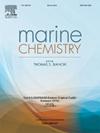东澳大利亚海流溶解铜的生物地球化学循环
IF 2.5
3区 地球科学
Q2 CHEMISTRY, MULTIDISCIPLINARY
引用次数: 0
摘要
铜(Cu)是一种重要的微量元素,参与了海洋浮游植物的多种代谢过程。然而,铜浓度超过生物体特异性耐受水平可能是有毒的。测定海水中稳定Cu同位素组成是更好地了解海洋环境中微量元素生物地球化学循环的有效工具。本文报道了南太平洋西边界流东澳大利亚流(EAC)水体中溶解铜(dCu)的浓度和同位素组成。这次航行是在2018年的南方春季进行的,GEOTRACES过程研究GPpr13由南北样带组成,由南大洋太平洋部分从温暖、咸的亚热带(ST)水域到寒冷、新鲜的亚南极(SA)水域的过渡分类。上层水柱平均dCu同位素组成(δ65dCu)自北向南增加~ 0.3‰。EAC北部台站地表水δ65dCu总体同位素较轻,混合层δ65dCu值在0.25‰~ 0.31‰之间。混合层δ65dCu值在东太平洋南缘为0.20‰~ 0.47‰,在亚南极带为0.54‰~ 0.63‰。总体而言,δ65dCu剖面在上层水柱(200 m)表现出显著的变化,δ65dCu组成在叶绿素a最大深度更重,特别是在高生产力站,这可能归因于生物吸收和/或清除。在叶绿素A浓度较低的站点,由于上层水体中重同位素的有机络合作用较强,地表δ65dCu同位素特征相对较深。其中一个亚南极站(10站)的深海(≥2000 m) δ65dCu较轻(0.25±0.06‰),表明可能存在轻同位素Cu的底栖补给。该研究提供了高分辨率的δ65Cu数据集,为Cu在海洋中的生物地球化学循环提供了新的见解。本文章由计算机程序翻译,如有差异,请以英文原文为准。
Biogeochemical cycling of dissolved Cu along the East Australian Current
Copper (Cu) is an important micronutrient that is involved in multiple metabolic processes in marine phytoplankton. However, Cu concentrations that exceed an organism-specific tolerance level can be toxic. The measurement of stable Cu isotopic composition in seawater is an effective tool to better understand the biogeochemical cycling of this micronutrient in the marine environment. Here, we report the dissolved Cu (dCu) concentration and isotope composition of waters of the East Australian Current (EAC), the western boundary current in the south Pacific. The voyage was undertaken in 2018 during the austral spring as GEOTRACES process study GPpr13 consisting of a north-south transect categorised by the transition from warm, salty subtropical (ST) waters to the cold, fresh subantarctic (SA) waters in the Pacific sector of the Southern Ocean. The average dCu isotope composition (δ65dCu) of the upper water column increased by ∼0.3 ‰ from north to south. The northern EAC stations generally had isotopically lighter dCu in surface waters, with mixed layer δ65dCu values ranging from 0.25 ‰ to 0.31 ‰. Mixed layer δ65dCu values ranged from 0.20 ‰ to 0.47 ‰ at the southern extension of the EAC and from 0.54 ‰ to 0.63 ‰ in the subantarctic zone. Generally, δ65dCu profiles showed significant variability in the upper water column (200 m). The δ65dCu composition was heavier at depths of chlorophyll a maxima, particularly for the high productivity stations, which can be attributed to either biological uptake and/or scavenging. A heavier surface δ65dCu isotopic signature relative to deeper waters was also observed at stations with low chlorophyll a concentrations due to strong organic complexation of the heavy isotope in the upper water column. The deep ocean (≥2000 m) δ65dCu at one of the subantarctic stations (station 10) was considerably lighter (0.25 ± 0.06 ‰), indicating a possible benthic supply of isotopically light Cu. This study provides a high-resolution δ65Cu dataset, affording new insights into the biogeochemical cycling of Cu in the ocean.
求助全文
通过发布文献求助,成功后即可免费获取论文全文。
去求助
来源期刊

Marine Chemistry
化学-海洋学
CiteScore
6.00
自引率
3.30%
发文量
70
审稿时长
4.5 months
期刊介绍:
Marine Chemistry is an international medium for the publication of original studies and occasional reviews in the field of chemistry in the marine environment, with emphasis on the dynamic approach. The journal endeavours to cover all aspects, from chemical processes to theoretical and experimental work, and, by providing a central channel of communication, to speed the flow of information in this relatively new and rapidly expanding discipline.
 求助内容:
求助内容: 应助结果提醒方式:
应助结果提醒方式:


